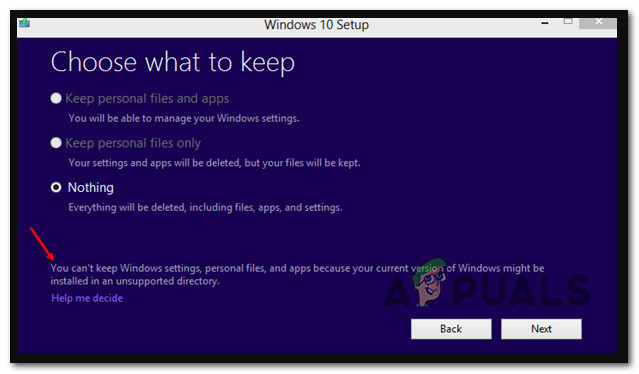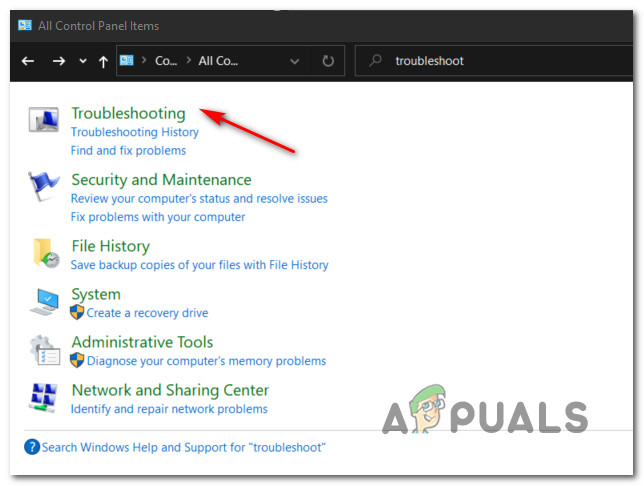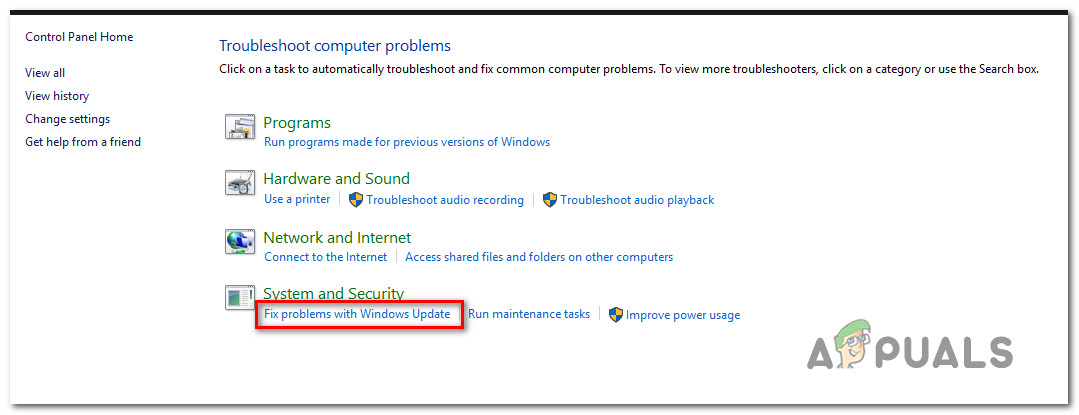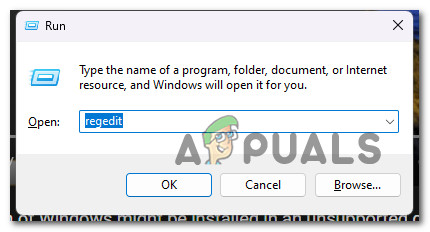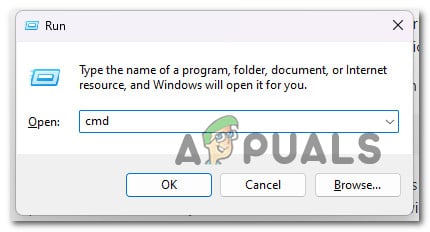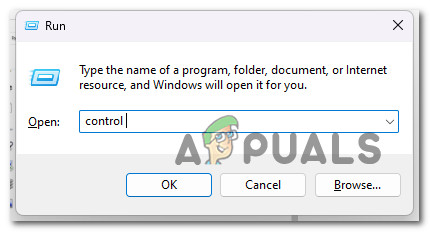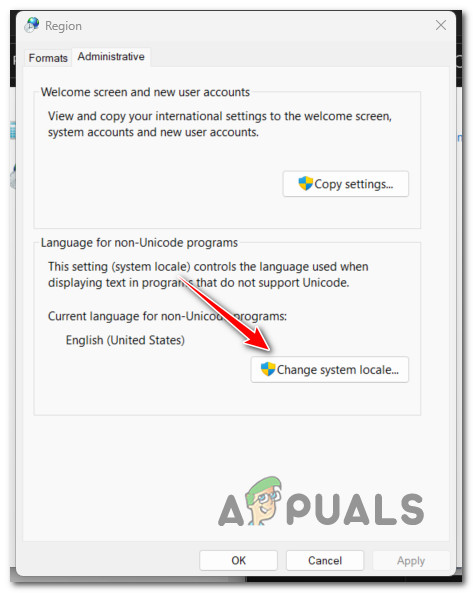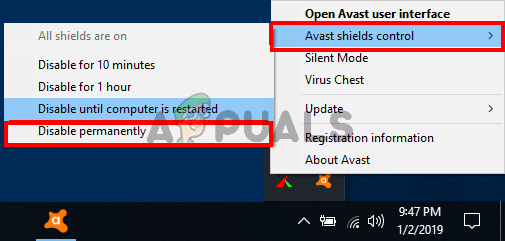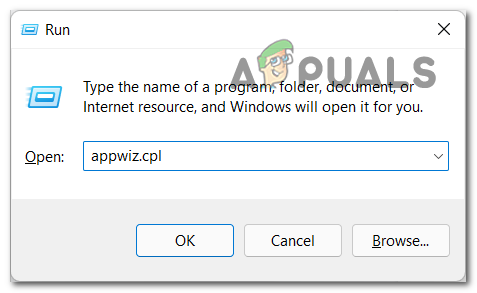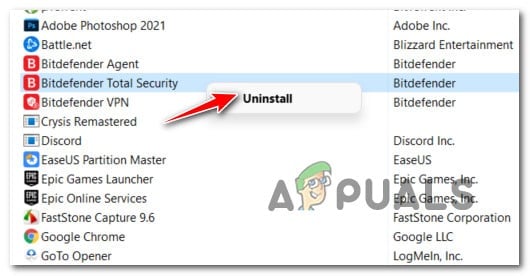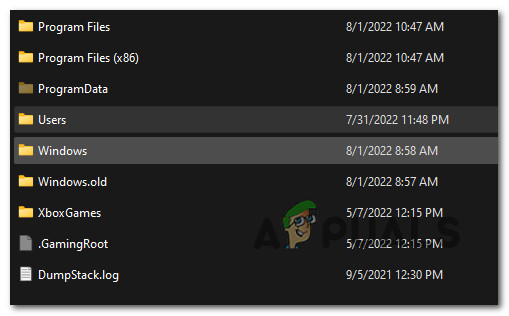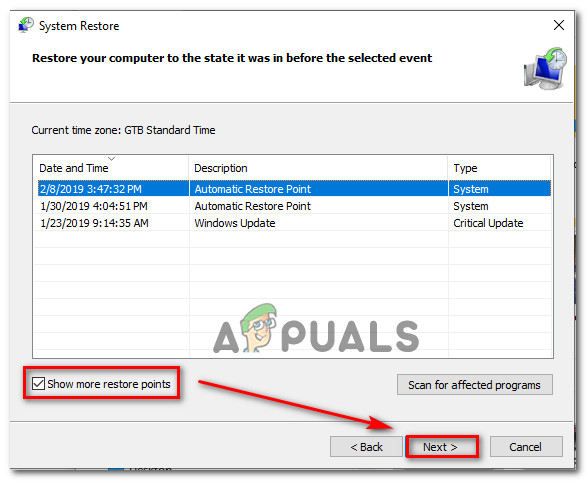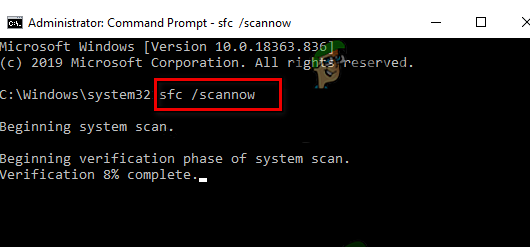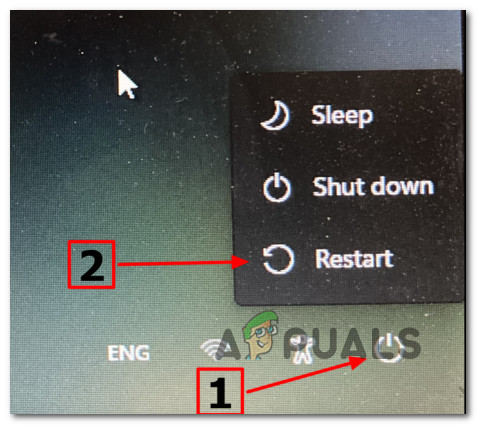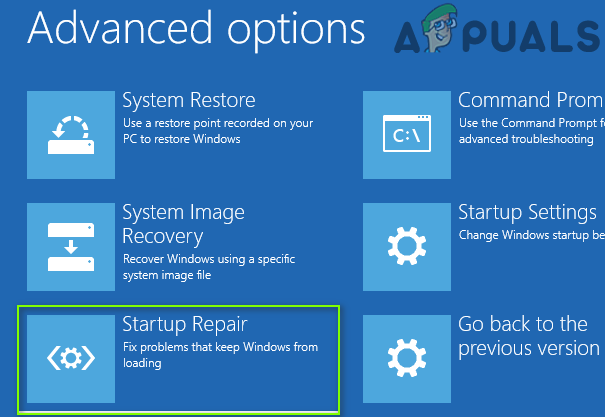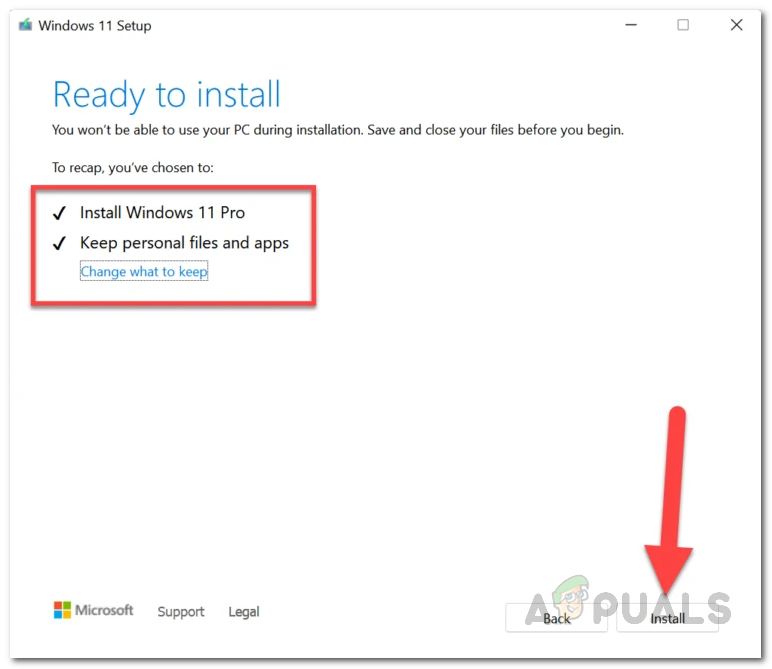After investigating this particular issue, we realized that there are actually multiple potential causes that will ultimately trigger this behavior on the two most recent Windows versions. Here’s a list of scenarios that you should investigate: Now that we have gone over every potential reason why you might see this problem occurring, let’s get to the actual fixing part. Below you have a collection of methods that other users have successfully used to get to the bottom of the issue.
1. Run the Windows Update Troubleshooter
As it turns out, you may anticipate dealing with this issue whenever there is a fundamental Windows Update component issue (which is needed during the clean install or upgrade procedure). If this situation applies, running the Windows Update troubleshooter will probably help you resolve the problem. If the error’s root cause is already covered by a Microsoft repair plan provided by the Windows Update Troubleshooter, fixing the problem only requires running the program and applying the suggested fix. The Windows Update Troubleshooter is intended to automatically identify and resolve common problems, even if you’ve never used it before. Notably, Windows 11 users are in luck as the tool is far more thorough than earlier iterations. Microsoft has included a number of new automated repair methods that can be launched in a matter of seconds if an identified cause is discovered. If you haven’t already, follow the steps below to launch the Windows Update Troubleshooter and have the proposed remedy automatically applied: Continue to the following possible solution below if you are still unable to install or complete the upgrade procedure.
2. Change the specified location of Program Files via Registry Editor
Additionally, you can anticipate this issue to arise if the upgrade wizard is unable to locate the default Windows 10 program directories (either as a result of wrongly supplied or manually modified location). In this scenario, you can resolve the problem by modifying the intended location of Program Files in the Registry Editor. Note: It’s important to open Registry Editor with admin access in order to carry on these commands. For good measure, we also recommend backing up your Registry before you start following the instructions below. If you suspect that this method might be applicable to your particular scenario, follow the instructions below to change the specified location of Program files via Registry Editor: If the problem is still not fixed, move down to the next method below.
3. Resetting all Windows Update components
Since both the upgrade and reinstall processes rely on the Windows Update component, it’s crucial to make sure that it is operating properly. By displaying each Windows Update component, you can resolve the issue if there is a fundamental issue with the subcomponent or related dependencies (and the in-use folders). If you’ve reached this point in the upgrade process without finding a solution, it’s likely that you’re dealing with corruption in the WU component or one of its related dependencies. In this situation, we advise using a series of CMD commands to reset every WU component as well as the WU management folders. The majority of the time, one or more WU (Windows Update) components that are presently stuck in limbo are the root cause of this kind of problem (neither open nor closed). If so, you can resolve the issue by resetting every WU component engaged in the update procedure. In this case, reset each Windows Update component by following the instructions listed below: Move on to the next potential solution below if you continue to receive the same issue.
4. Set Status of Windows Update & Associated Dependencies to Automatic
Contrary to popular opinion, Windows Update depends on a lot of different services. These services must be set up so that the WU component can get in touch with them whenever necessary. If you’re employing performance-optimizing technologies, some of these service requirements might have been altered to remain disabled in order to increase the effectiveness of your system. To ensure that Windows Update has all it needs to finish the upgrading process, you must set the following services to AUTO: • BITS (Background Intelligent Transfer Service) • CryptSvc ( Cryptographic Services) • TrustedInstaller By using an elevated Command Prompt to make sure that the beginning type of each of these services is set to Auto, you are effectively guaranteeing that every WU service requirement is available. Follow the steps below to set these services’ behavior to AUTO so that the upgrading process is successful without the “Windows Might Be Installed in an Unsupported Directory” warning: If the problem is still not resolved, move down to the next method below.
5. Adjust the system locale (if applicable)
Many Windows users who have experienced this problem claim that it frequently happens if the language for non-Unicode programs is set to a language other than the one that is set as the default system language. If this is the case, you can resolve the problem by changing the system locale to reflect your installed language. If this scenario is applicable and your default language is different than the language set for non-Unicode programs, follow the instructions below to adjust the system locale accordingly: If you’re still experiencing the same ‘Windows Might Be Installed in an Unsupported Directory’ error when attempting to carry over the upgrading procedure, move down to the next method below.
6. Disable or Uninstall antivirus
It’s possible that a false positive is genuinely hurting the transferring procedure and causing the error if you’re using a third-party security suite or firewall. Most impacted customers using both third-party firewalls and third-party security suites have confirmed that this issue occurs. Note: There is no proof that Windows Defender can conflict with the service in charge of moving or copying files on Windows 10 or 11, therefore avoid utilizing this method entirely if you’re using it. If you’re using a third-party security option, you should disable it first before launching Windows Backup. You can usually disable a third-party security option straight from the security suite’s tray icon. The majority of third-party security solutions allow you to off real-time protection by simply right-clicking on the icon in the tray bar of your third-party antivirus program. IMPORTANT: Remember that if a firewall is the root of the problem, stopping the third-party security suite won’t likely solve the problem because the firewall will continue to function even after the third-party security suite is off. If you’re using a firewall or merely turning off real-time protection does not resolve the issue, try uninstalling the third-party firewall using the steps below to see if that resolves your situation: If this approach didn’t work for you or you’re still getting the same error when attempting to initiate an upgrade process, scroll down to the next possible solution below.
7. Move the User folder back to its place
The upgrading process of Windows 10 or Windows 11 will be unable to identify the files required for the recovery process unless the ‘user’ folder is not in the anticipated place. You can resolve the problem by relocating the “user” folder to the appropriate location if you accidentally moved it (or if an optimization program relocated it for you). If this scenario seems like it could be applicable, follow the instructions below to move the User folder back to the correct location: If the issue is still not fixed, move down to the next method below.
8. Using the System Restore
Several user’s reports that we received about this error indicate that it frequently happens following a system change that ended up interfering with the Windows Update component. You can quickly resolve this problem by returning your PC to a time when it was operating normally if you have a working System Restore Snapshot. According to numerous afflicted users, you may expect to deal with this issue after a recent system modification (like the installation of an infrastructure update, a driver update, or a cleanup procedure performed by an antivirus). By utilizing System Restore to return your system to a functioning state before attempting to restart the upgrading process, the majority of the harm, in this case, can be minimized. Important: Keep in mind that executing this operation would nullify all changes made after the system restore point was created. All installed apps, changed system preferences, and anything else will all be gone. If you decided to restore your system, take the following actions: Try the following approach if the issue is still not resolved.
9. Perform DISM and SFC scans
As it turns out, a system file corruption that affects the auto-updating function of Windows installation is one of the most frequent reasons for this problem when the upgrade procedure fails with the “Windows Might Be Installed in an Unsupported Directory” error. System File Checker (SFC) and Deployment Image Servicing and Management (DISM) are two built-in tools that can be used to do a scan if this condition appears to be relevant. Although SFC and DISM have certain similarities, we advise running them both quickly after one another to increase your chances of recovering corrupted system files. If so, begin with a straightforward SFC scan. Remember that you can use this tool without an internet connection at all times because it is completely local. IMPORTANT: DO NOT CLOSE THE CMD WINDOW AFTER BEGINNING THIS PROCEDURE, EVEN THOUGH THE UTILITY SEEMS TO HAVE FROZEN. Interrupting the operation could result in logical errors on your HDD or SSD, wait for it to finish without interfering. Once the SFC scan has been completed successfully, restart your computer, and after the next startup is complete, deploy a DISM scan. Be aware that SFC does not download healthy replacements to replace corrupt system files, but DISM does use a component of Windows Update. So, before beginning this step, make sure your Internet connection is steady. After the DISM scan has been successfully completed, see if the upgrade operation still prompts the same kind of issue. If the problem persists, move down to the next potential fix below.
10. Perform an automated repair
In rare instances, file corruption in your system files can lead to this kind of issue. To see if the issue has been resolved in this case, you need to do a startup repair first. In this situation, a starting repair ought should be able to fix the issue. A Windows recovery tool called Automated Startup Repair can fix the vast majority of common system problems that prevent your Windows installation from booting. Like any other Windows automated troubleshooter, this one offers a number of automatic repair options that can be used if a problem is found. You won’t likely be able to start up normally, therefore you’ll need to use the Recovery Menu to launch a Startup Repair operation. If this describes you, follow the procedures listed below to start a Startup Repair operation: Try the next technique below if you’re still experiencing the “Windows Might Be Installed in an Unsupported Directory” issue.
11. Reset every Windows component
There’s a good probability that you’re genuinely dealing with a system file corruption that can’t be fixed conventionally if none of the other methods listed above have been able to remedy the “Windows Might Be Installed in an Unsupported Directory” error. If you reach this stage, your best chance of resolving the problem conventionally is to perform a clean install or install repair on every Windows component (in-place repair). A clean installation is a process that is the simplest of the bunch. The main benefit of this method is that you won’t need to utilize appropriate installation media, but bear in mind that unless you back up your data first, you will lose all of your personal data that is currently on your OS driver. Start a repair install if you prefer the concentrated method. But keep in mind that you’ll need suitable installation discs (in-place repair procedure). Note: Refreshing every potentially corrupted component without losing data from your programs, games, papers, and personal material that is now saved on your OS drive is the main benefit of this operation, which is noticeably more time-consuming.
How to Fix Diablo 2 Error Code 1 - Unsupported Graphics on Windows 10Fix: Unsupported 16-bit Application ErrorHow to Fix “Secure Boot State Unsupported” on Windows?Fix: SD Card is Blank or Has Unsupported Filesystem
